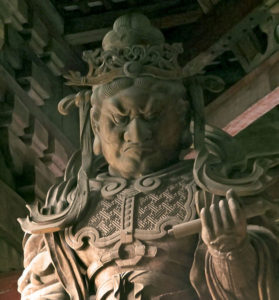Printable Sites Overview Itinerary & Daily Costs
Uji & Nara
Day 8
August 8, 2022
Today’s adventure will be split between two cities just south of Kyoto, Uji and Nara.
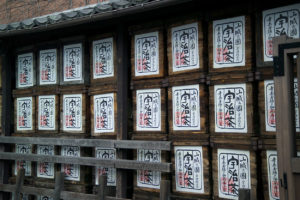
Uji
Uji, city, Kyōto fu (urban prefecture), west-central Honshu, Japan . It lies along the Uji River in the southeastern corner of the Kyōto Basin. It developed in about the 7th century as a river crossing. During the Tokugawa era (1603–1867) it was the main post town on the road between Nara and Ōtsu. Uji is best known as the place where tea was first cultivated in Japan in the Muromachi era (1338–1573). High-quality green tea is still grown on the fertile alluvial fan of the Uji River, and there is cormorant fishing in the river. Among its many historic temples and shrines is the Byōdō Temple, which was built as a residence in the mid-11th century for a minister who later converted the building into a Buddhist temple when he became a Buddhist monk. (Britannica, T. Editors of Encyclopaedia (2016, May 2). Uji. Encyclopedia Britannica. https://www.britannica.com/place/Uji-Japan)
Uji Bridge
We will begin our day with a walking tour of Uji. Our very first attraction will be the Uji Bridge. The area around Uji Bridge is a link to great stories of Japan’s past, both historical and fictional. Scenes from the literary classic, Tale of Genji, as well as real life episodes in the history of Japanese tea intertwine to form a rich cultural background.
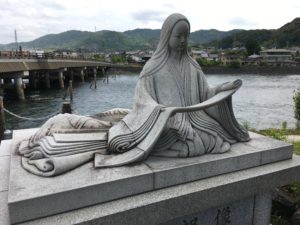

Sawarabi StreeT & Daikichiyama
Next we will head for Sawarabi Street, a historical area and the Daikichiyama Observations deck. The Daikichiyama Observatory gives a great overview of Uji.
Ujigami & Uji Shrines
Continuing along Sawarabi Street, we will make our way to Ujigami and Uji Shrines.
Ujigami Shrine (宇治上神社, Ujigami Jinja) is believed to be the oldest standing shrine in Japan. Although there is no official record of when it was first constructed, experts estimate that Ujigami Shrine was well established by 1060. It was closely linked to Byodoin Temple as its “guardian shrine”.
A hundred meters south of Ujigami Shrine stands Uji Shrine, also built in the nagare-zukuri style. The two shrines used to be one until they were separated during the Meiji Period (1868-1912). Ujigami Shrine used to be known as the upper shrine while Uji Shrine was the lower shrine.
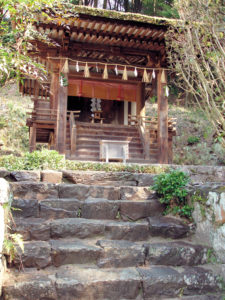
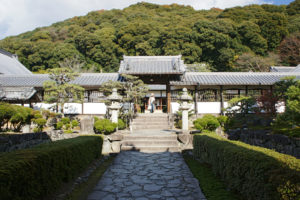
Kosho-ji Temple
This temple of the Soto Zen school of Buddhism was a training hall opened in Fukakusa (Fushimi) by the Buddhist monk Dogen in the Kamakura Period (1192-1333). It was later reconstructed in 1648 by Lord Nagai Naomasa of Yodo Castle, using the remains of Fushimi Castle. Highlights amongst the seven structures in the temple grouds include the Kotozaka, the approach to the temple that forms a tunnel of fall foliage in autumn; the temple gate made in the Ryugu-zukuri architectural style; “nightingale” hallway floors that squeak to alert those within of intruders; the Tenarai Kannon bodhisattva as mentioned in the classic “The Tale of Genji”; and chitenjo ceilings.
Matcha Grinding Or Tea Roasting Experience
The Fukujuen Tea Studio offers many tea experiences. We will be participating in the Matcha Grinding or Tear Roasting Experience this time.
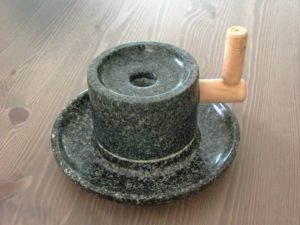
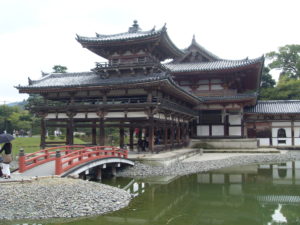
Byodo-in Temple
Byodoin Temple (平等院, Byōdōin) is a striking example of Buddhist Pure Land (Jodo) architecture. Together with its garden , the temple represents the Pure Land Paradise and was influential on later temple construction. Byodoin was initially built in 998 as a countryside retreat villa for the powerful politician Fujiwara no Michinaga , not as a temple.
Byodo-in Omotesando
Almost every Temple or Shrine in Japan has an Omotesando or shopping street nearby and Byodoin is no exception. The main difference between Byodoin’s Omotesando and others is the content. Byodoin Omotesando is your place for all things green tea! When you visit Byodoin Omotesando, you will often see this Japanese character 茶, pronounced ‘cha’. It means green tea in Japanese and Uji is known for the best green tea in Japan. You will find sellers of green tea mochi, soba and ice cream along with stores selling and making different varieties of green tea. Enjoy!
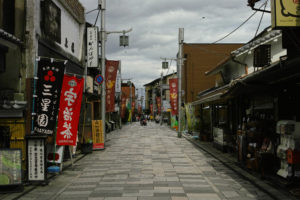

Nara
Nara, city, Nara ken (prefecture), southern Honshu, Japan. The city of Nara, the prefectural capital, is located in the hilly northeastern edge of the Nara Basin, 25 miles (40 km) east of Ōsaka. It was the national capital of Japan from 710 to 784—when it was called Heijō-kyō—and retains the atmosphere of ancient Japan. The city is most noted for the many ancient Japanese Buddhist buildings and artifacts in and around the city, including the Seven Great (and many ancient but lesser) Temples of Nara. The five-storied pagoda of the Kōfuku Temple dates from 710. The Tōdai Temple (745–752) is noted for the Daibutsu, or Great Buddha, a giant statue about 50 feet (15 m) high that is housed in the Great Buddha hall, one of the largest wooden buildings in the world. The nearby Shōsō Repository (761), a log storehouse raised above the ground on stilts, was built to hold the thousands of 8th-century treasures of the Tōdai Temple. Its artwork and artifacts (now housed in fireproof concrete buildings) include jewels, musical instruments, masks, paintings, sculpture, samples of calligraphy, and household items. The Grand Shrine of Kasuga is one of Japan’s oldest Shintō shrines. These ancient remnants of early Japanese civilization form the basis of Nara’s tourism industry, which has wide appeal to foreigners as well as Japanese. Nara’s status as a national cultural monument is reflected in a Japanese proverb: “See Nara and die”; i.e., one can die content if one has seen Nara. The historic monuments at Nara were designated a UNESCO World Heritage site in 1998. (Britannica, T. Editors of Encyclopaedia (2019, May 30). Nara. Encyclopedia Britannica. https://www.britannica.com/place/Nara-Japan)
Kasuga Taisha
Kasuga Taisha (春日大社) is Nara’s most celebrated shrine. It was established at the same time as the capital and is dedicated to the deity responsible for the protection of the city. Kasuga Taisha was also the tutelary shrine of the Fujiwara, Japan’s most powerful family clan during most of the Nara and Heian Periods. Like the Ise Shrines, Kasuga Taisha had been periodically rebuilt every 20 years for many centuries. In the case of Kasuga Taisha, however, the custom was discontinued at the end of the Edo Period.
Beyond the shrine’s offering hall, which can be visited free of charge, there is a paid inner area which provides a closer view of the shrine’s inner buildings. Furthest in is the main sanctuary, containing multiple shrine buildings that display the distinctive Kasuga style of shrine architecture, characterized by a sloping roof extending over the front of the building.
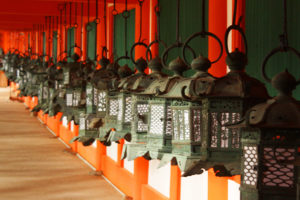
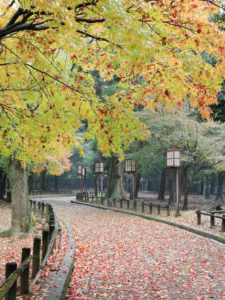
Nara PArk
Nara Park (奈良公園, Nara Kōen) is a large park in central Nara. Established in 1880, it is the location of many of Nara’s main attractions including Todaiji, Kasuga Taisha, Kofukuji and the Nara National Museum. It is also home to hundreds of freely roaming deer. Considered the messengers of the gods, Nara’s over 1000 deer have become a symbol of the city and have even been designated as a natural treasure. Deer crackers are for sale around the park, and some deer have learned to bow to visitors to ask to be fed. Nara’s deer are surprisingly tame, although they can be aggressive if they think you will feed them, so make sure not to tease them with food.
Todai-ji Temple
Todaiji (東大寺, Tōdaiji, “Great Eastern Temple”) is one of Japan’s most famous and historically significant temples and a landmark of Nara. The temple was constructed in 752 as the head temple of all provincial Buddhist temples of Japan and grew so powerful that the capital was moved from Nara to Nagaoka (south of Kyoto and west of Uji) in 784 in order to lower the temple’s influence on government affairs.
Until recently, Todaiji’s main hall, the Daibutsuden (Big Buddha Hall), held the record as the world’s largest wooden building, despite the fact that the present reconstruction of 1692 is only two thirds of the original temple hall’s size. The massive building houses one of Japan’s largest bronze statues of Buddha (Daibutsu). The 15 meters tall, seated Buddha represents Vairocana and is flanked by two Bodhisattvas.
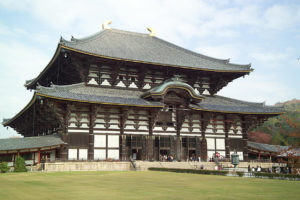
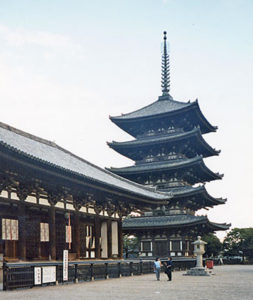
Kofuku-ji Temple
Kofukuji (興福寺, Kōfukuji) used to be the family temple of the Fujiwara, the most powerful aristocratic clan during much of the Nara and Heian Periods. The temple was established in Nara at the same time as the capital in 710. At the height of Fujiwara power, the temple consisted of over 150 buildings.
The temple features several buildings of great historic value, including a five-storied pagoda and a three-storied pagoda. At 50 meters, the five-storied pagoda is Japan’s second tallest wooden pagoda, just seven meters shorter than the five-storied pagoda at Kyoto’s Toji Temple. Kofukuji’s pagoda is both a landmark and symbol of Nara. It was first built in 730, and was most recently rebuilt in 1426. Neither pagoda can be entered by the public.
While entrance to Kofukuji’s temple grounds is free and possible around the clock, there are three areas that require paying an entrance fee: The Central Golden Hall, the Eastern Golden Hall and Kofukuji’s National Treasure Museum.
Higashimuki Shopping District
This covered shopping arcade close to Nara Park has a good selection of restaurants and souvenir shops, and is a good option on rainy days. Adjoining Kintetsu Nara Station, it tends to get crowded in the early evening. This will be our final destination for the evening, so make sure you fill up on all of your Nara souvenirs!

